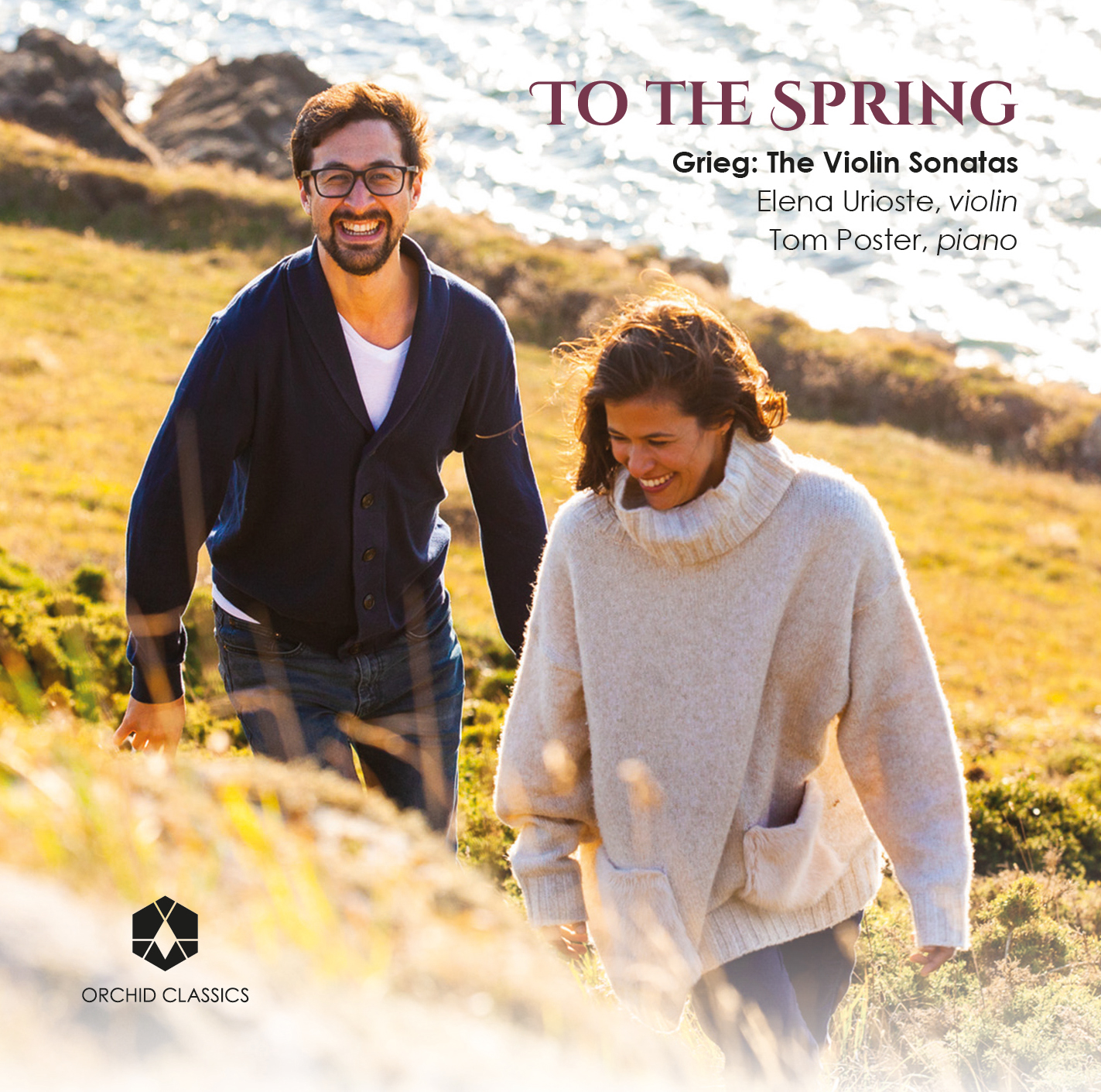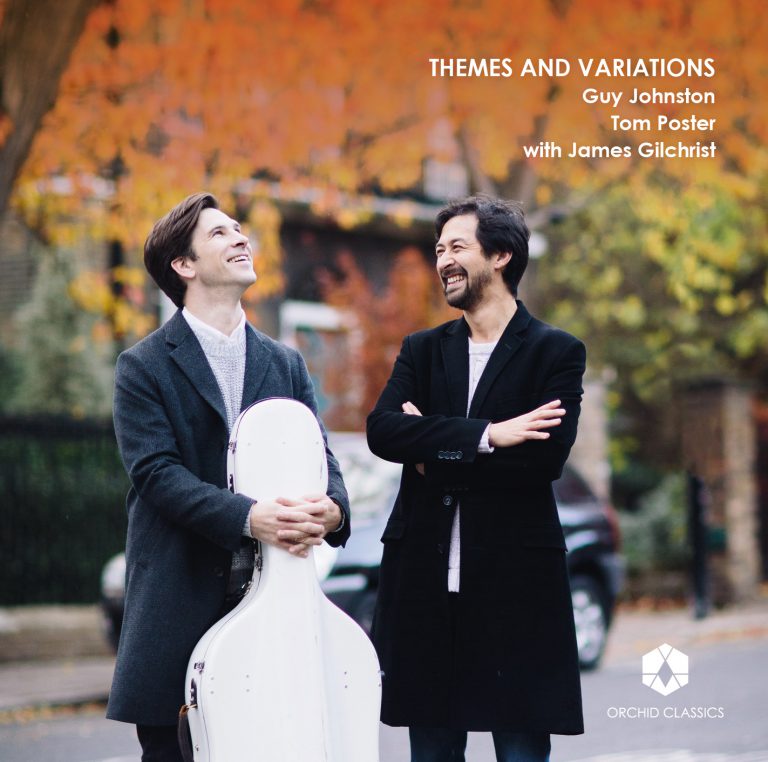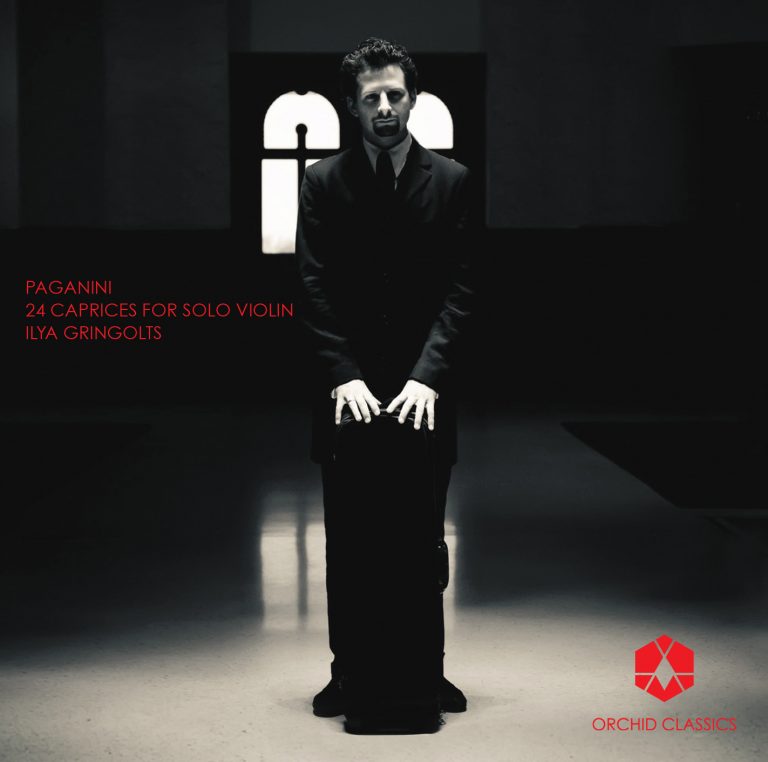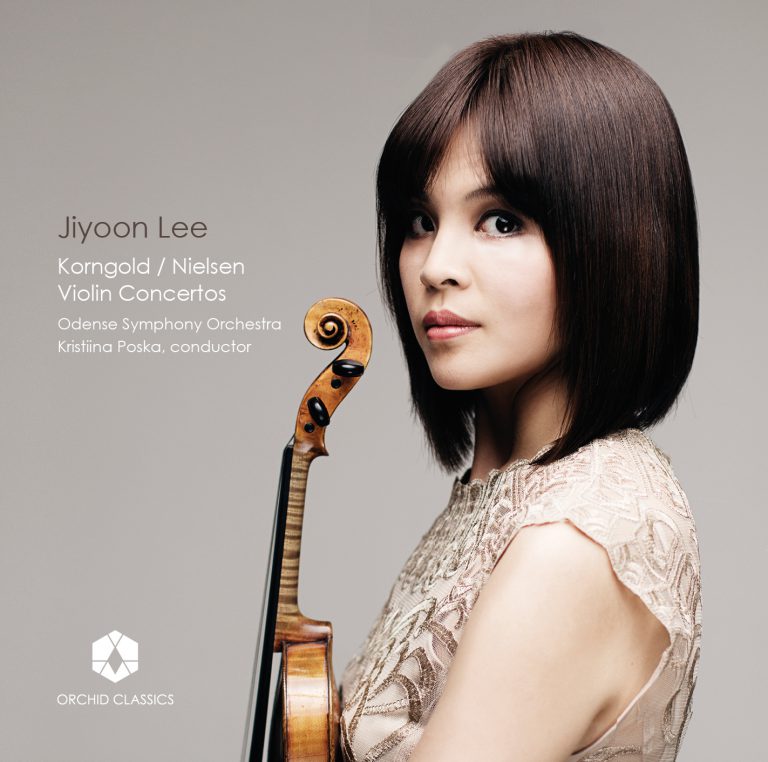Artist Led, Creatively Driven

To The Spring
Elena Urioste, violin
Tom Poster, piano
Release Date: March 6th 2020
ORC100126
Edvard Grieg (1843-1907)
Violin Sonata No.1 in F major, Op.8
1 Allegro con brio 9.42
2 Allegretto quasi andantino 5.14
3 Allegro molto vivace 7.34
4 Våren (Last Spring), Op.33 No.2 4.38
(arr. Poster and Urioste)
Violin Sonata No.2 in G major, Op.13
5 Lento doloroso – Allegro vivace 9.37
6 Allegretto tranquillo 6.11
7 Allegro animato 5.39
8 Til våren (To the Spring), Op.43 No.5 3.56
(arr. Poster and Urioste)
Violin Sonata No.3 in C minor, Op.45
9 Allegro molto ed appassionato 9.20
10 Allegretto espressivo alla Romanza 7.17
11 Allegro animato – Prestissimo 7.39
Total time 76.49
Elena Urioste, violin
Tom Poster, piano
Shortly before we made this recording, we paid a visit to Troldhaugen, near Bergen, where Grieg made his home for the last 20 summers of his life. Two things in particular stick in the memory: the warmth of tone of Grieg’s 1892 Steinway piano, which Tom had the privilege of playing; and the extraordinary natural beauty of the surroundings, with Grieg’s composing hut overlooking the serene Nordås Lake.
Grieg is a composer we have both adored since childhood. Like the environment in which he composed, his music has a disarming honesty and naturalness, infused with lyrical warmth, folk-inspired beauty and echoes of the Norwegian landscape.
Of Grieg’s three violin sonatas, it is the third which has become part of the core repertoire, and it was one of the first collaborative works Elena ever played. Yet the two earlier sonatas, relatively rarely heard, are at least as enchanting. Heard together, the three works chart a journey through Grieg’s life, and he retrospectively highlighted their differences: “the first naïve, rich in ideas, the second national and the third with a wider horizon”.
As palate cleansers between the sonatas, we transcribed two of our favourite Grieg miniatures not originally written for violin and piano. Both are evocations of spring, a very special season to Norwegians, beheld with sadness and wonder as the landscape quickly transitions from thick snow to green growth. The nostalgic purity of Våren has made it one of Tom’s desert island songs, while Elena was immediately captivated by Til våren, a more hopeful springtime evocation from the Lyric Pieces for solo piano.
In a world which often seems fraught with over-complication and disharmony, Grieg’s music – filled with childlike wonder and clear mountain air – transports us to a simpler, kinder place. We hope you love these pieces as much as we do.
Elena & Tom, 2019
In 1900 Edvard Grieg, then aged 56, surveyed his output and declared that his three violin sonatas represented some of his best music, charting the development of his style. As Grieg wrote to the writer Bjørnstjerne Bjørnson in a letter dated January 1900: “the first [is] naïve, rich inideas, the second national and the third with a wider horizon”. Grieg completed very little chamber music: only five works in all, of which three are violin sonatas. The other two are the String Quartet, Op.27 and the Cello Sonata, Op.36, plus a handful of unfinished pieces. What’s more, Grieg did not usually return to major forms; he wrote one piano concerto, one symphony, one piano sonata, so the fact that he devoted himself to three violin sonatas gives us an idea of his real affinity with this combination of instruments.
Grieg was a pianist, but his understanding of the violin dated back to a formative musical influence, the composer and violinist Ole Bull, who recognised the young Grieg’s potential and successfully urged Grieg’s parents to send their 15-year-old son to the recently-established Leipzig Conservatoire. Bull was a composer in the national Norwegian style at a time when Norway was still under Swedish rule. He drew upon the distinctive music of Norway’s national instrument, the Hardanger fiddle or hardingfele, a type of violin with eight or nine strings, four of which are played as they would be on a conventional instrument, while the rest are ‘sympathetic strings’ that resonate to create an underlying drone.
Grieg composed his Violin Sonata No.1 in F, Op.8, in 1865, when he was 22. The work was premiered in Leipzig by the Swedish violinist Anders Petterson, with Grieg at the piano. The sunny first movement opens with a flexible violin melody, infused with subtle folk inflections and supported by wide-ranging harmonies in the piano. Grieg’s profusion of melodic ideas is balanced by moments of restraint, as though he is allowing his ideas time to breathe. The second movement combines elements of both slow movement and Scherzo and Trio, and is a more overt emulation of the Hardanger fiddle, with double stopping used in the Trio section to evoke the instrument’s drone. The rich finale includes a generous three main themes, rather than the conventional two. When the Sonata No.1 was published, it attracted the attention of Franz Liszt, who wrote to Grieg in December 1868:
Sir,
I am glad to be able to tell you of the sincere pleasure that I have derived from reading through your Sonata, Op.8. It bears witness to a talent for composition – vigorous, reflective, inventive, and of excellent material – which has only to follow its own way to rise to the heights. I assume that in your own country you receive the success and encouragement you deserve. You will not lack these elsewhere, either: and if you come to Germany this winter, I warmly invite you to visit Weimar for a while, so that we may get to know each other.
Grieg composed his Twelve Songs, Op.33 between 1873 and 1880. The second song is entitled Våren – Last Spring, and was reworked in 1880 by Grieg as one of Two Elegiac Melodies, Op.34 for string orchestra, published in 1881. We hear an arrangement for violin and piano made by Elena Urioste and Tom Poster. The Op.33 songs are to poetry by Norwegian writer Aasmund Olavsson Vinje; The Last Spring is a bittersweet text in which the poet celebrates the appearance of Spring emerging from Winter’s snow, but reflects that he may be seeing this change for the last time. Grieg perfectly captures the poem’s tone of wistful resignation with his nostalgic melody and subtle harmonies.
By the time Liszt wrote his effusive letter to Grieg, the Violin Sonata No.2 was already complete. Grieg composed the work soon after his honeymoon in 1867; only two years after the Sonata No.1. Much had changed in that time: Grieg’s style had taken on a more distinctly Norwegian character, and the influence of Robert Schumann, audible in the Sonata No.1, receded, allowing Grieg’s own voice to emerge with greater clarity. In 1869, Grieg and his wife Nina visited Italy, where, at last, they met Liszt. Grieg arrived with a package under his arm containing the score to the Op.13 Violin Sonata, which Liszt seized with alacrity:
(Liszt) now commenced to turn over the pages, that is to say, he skimmed over the first movement of the sonata… he soon showed by significant nods or a ‘bravo’, or a ‘sehr schön’ when he came across one of the best passages. He had now become interested, but my courage dropped below zero when he asked me to play the sonata. It had never occurred to me to attempt the whole score on the piano…
… So I started on this splendid American grand piano, a Chickering. Right at the beginning, where the violin starts in with a rather baroque but national passage, he exclaimed: ‘Ei wie keck! Nun hören Sie mal, das gefällt mir. Noch einmal bitte!’ (‘How bold that is! Look here, I like that. Once more, please!’) And where the violin again comes in adagio, he played the violin part on the upper octaves of the piano with an expression so beautiful, so marvellously true and singing, that it made me smile inwardly. These were the first tones I heard Liszt play; and now we passed rapidly into the Allegro, he taking the violin part, and I the piano. My spirits rose gradually, because his approval, which he manifested in a truly lavish way, did me good.
Liszt then took to the piano and went on to sight-read, flawlessly, the rest of the sonata – both violin and piano parts – to Grieg’s delight. Grieg’s use of the words “baroque” and “national” to describe the first movement highlights its moments of refined decoration, as well as its Norwegian flavour.
The work opens with a mournful, folk-like slow introduction, giving way to a lyrical violin melody accompanied by the piano’s repeated chords. The piano then introduces a livelier melody, with a vibrant violin outburst contrasted with softer, more mysterious passages. The slow movement begins in the manner of a lullaby, but the violin ushers inmore impassioned material, soaring above the piano’s dramatic flourishes. Despite the slower tempo, this is not a conventionally dreamy slow movement; as with the first movement, Grieg playfully shifts between moods, ending on a note of melancholy. Grieg saves the most quintessentially Norwegian material for the dancing finale, which is characterised by the sparkling, folk-like violin part and colourful, lilting music for the piano. The piece is dedicated to Johan Svendsen and was premiered in 1867 by Gudbrand Böhn, with Grieg at the piano.
The ten volumes of Grieg’s Lyric Pieces for solo piano were published in Leipzig, by the Peters publishing house; the first set, Op.12, was issued in 1867, the year of the Violin Sonata No.2. Til våren (To the Spring) is the sixth and last of the third volume of Lyric Pieces, Op.43 (1886), and is heard here in an arrangement for violin and piano, again made by the artists themselves.
Nearly two decades separate the Violin Sonatas Nos. 2 and 3. The Third Violin Sonata, in C minor, Op.45, was started in 1886 – the same year as To the Spring – and was finished early in 1887. Grieg wrote the sonata at his home in Troldhaugen; it was the last chamber music he completed. The Sonata No.3 was premiered on 10 December 1887 at the Leipzig Gewandhaus by the famous violinist Adolph Brodsky, with Grieg again playing the piano part. The work was an immediate success, selling 1500 copies within months of its publication.
The dramatic, exhilarating first movement immediately announces itself as darker-hued and less lyrical than its predecessors, with knotty, vigorous explorations of the material and fewer overt references to folk idioms. The radiant slow movement is in complete contrast, exuding an almost childlike sense of wonder, its brooding central section again so different that one might not guess it is thematically related to the delicate outer sections. The finale isstructurally unorthodox; Grieg repeats rather than extensively develops his material, including a foreboding marching theme that gives way to a yearning melody. In the final coda, Grieg transforms the sinister tone of the march as though snatching victory from the jaws of defeat, ending the work in a spirit of triumph.
© Joanna Wyld, 2020
Elena Urioste is a musician, yogi, writer, and entrepreneur. As a violinist, Elena has given acclaimed performances as soloist with major orchestras throughout the world, including the Philadelphia, Cleveland, and Minnesota Orchestras; the New York, Los Angeles, and Buffalo Philharmonics; the Boston Pops; the Chicago, San Francisco, National, Atlanta, Baltimore, and Detroit Symphony Orchestras; the London Philharmonic, Hallé, Philharmonia, and Royal Liverpool Philharmonic Orchestras; the BBC Symphony, Philharmonic, and National Orchestra of Wales; the Orchestra of Opera North; as well as the Malaysian Philharmonic, Orchestre National de Lille, Edmonton Symphony, Würzburg Philharmonic, Hungary’s Orchestra Dohnányi Budafok and MAV Orchestras, and the Chineke! Orchestra. She has regularly performed as a featured soloist in Carnegie Hall’s Stern Auditorium and has given recitals at the Wigmore Hall, Carnegie Hall’s Weill Recital Hall, Kennedy Center, Konzerthaus Berlin, Sage Gateshead, Bayerischer Rudfunk Munich, and Mondavi Center. Elena is a former BBC New Generation Artist (2012-14) and has been featured on the covers of Strings and Symphony magazines.
An avid chamber musician, Elena is the founder and Artistic Director of Chamber Music by the Sea, an annual festival on Maryland’s Eastern Shore. She has been a featured artist at the Marlboro, Ravinia, La Jolla, Bridgehampton, Moab, and Sarasota Music Festivals, as well as Open Chamber Music at Prussia Cove, the Cheltenham Music Festival, Switzerland’s Sion-Valais International Music Festival, and the Verbier Festival’s winter residency at Schloss Elmau.
Elena is a graduate of the Curtis Institute of Music and The Juilliard School. Notable teachers and mentors include Joseph Silverstein, David Cerone, Ida Kavafian, Pamela Frank, Claude Frank, Rafael Druian, and Ferenc Rados. The outstanding instruments being used by Elena are an Alessandro Gagliano violin, Naples c. 1706, and a Nicolas Kittel bow, both on generous extended loan from the private collection of Dr. Charles E. King through theStradivari Society of Chicago.
Elena has being practicing yoga for over a decade and received her RYT-200 hour certification from the Kripalu Center in June 2019. She is the co-founder of Intermission, a program that combines music, movement, and mindfulness, aiming to make music-making a healthier, more holistic practice for students and professionals alike through yoga and meditation.
www.elenaurioste.com
Tom Poster is a musician whose skills and passions extend well beyond the conventional role of the concert pianist. He has been described as “a marvel, [who] can play anything in any style” (The Herald), “mercurially brilliant” (The Strad), and as having “a beautiful tone that you can sink into like a pile of cushions” (BBC Music).
Tom has performed more than forty concertos ranging from Bach to Ligeti with the Aurora Orchestra, BBC Philharmonic, BBC Scottish Symphony, China National Symphony, Hallé, Philharmonia, Royal Philharmonic, Scottish Chamber Orchestra and St Petersburg State Capella Philharmonic, collaborating with conductors such as Vladimir Ashkenazy, Nicholas Collon, Thierry Fischer, Robin Ticciati and Yan Pascal Tortelier.
Tom features regularly on BBC radio and television and has made multiple appearances at the BBC Proms, and his exceptional versatility has put him in great demand at festivals internationally. He is a regular performer at Wigmore Hall, and is pianist of the Aronowitz Ensemble (former BBC New Generation Artists) and the Aronowitz Piano Trio. He enjoys established duo partnerships with Alison Balsom, Guy Johnston and Elena Urioste, and also collaborates with Ian Bostridge, Steven Isserlis, Matthew Rose and the Danish, Navarra and Škampa Quartets.
Tom has recorded solo albums for Champs Hill Records and Edition Classics, chamber music for Chandos, Decca Classics and Warner Classics, and regularly features as soloist on film soundtracks, including the Oscar-nominated score for The Theory of Everything. He studied with Joan Havill at the Guildhall School of Music and Drama, and at King’s College, Cambridge.
Increasingly in demand as a curator and innovative concert programmer, Tom is artistic director of Kaleidoscope Chamber Collective, an ensemble with a flexible line-up and an ardent commitment to diversity. He is also a successful composer and arranger, and a lifelong fan of animals with unusual noses.
www.tomposter.co.uk









